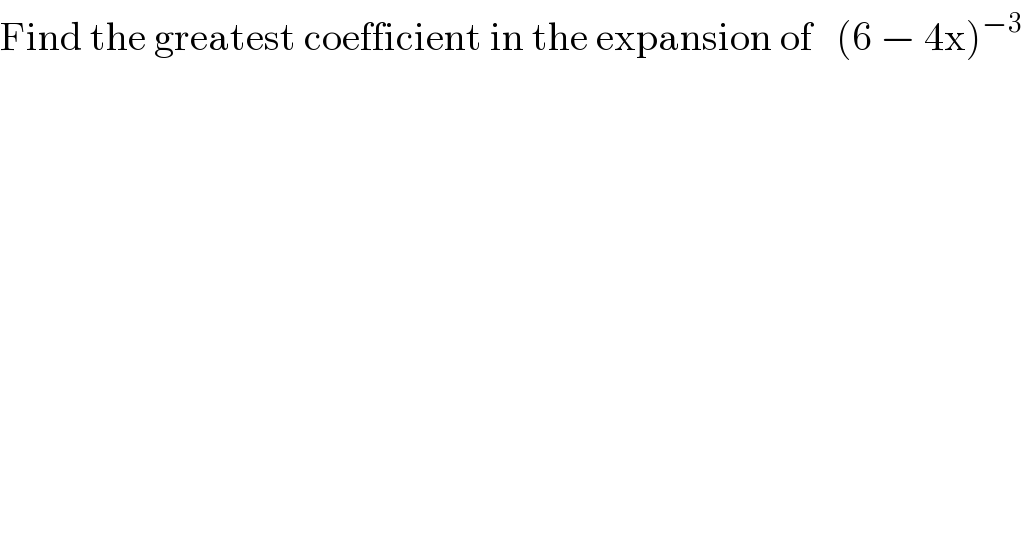
Question Number 62945 by Tawa1 last updated on 27/Jun/19

$$\mathrm{Find}\:\mathrm{the}\:\mathrm{greatest}\:\mathrm{coefficient}\:\mathrm{in}\:\mathrm{the}\:\mathrm{expansion}\:\mathrm{of}\:\:\:\left(\mathrm{6}\:−\:\mathrm{4x}\right)^{−\mathrm{3}} \\ $$
Answered by mr W last updated on 27/Jun/19

$$\left(\mathrm{6}−\mathrm{4}{x}\right)^{−\mathrm{3}} \\ $$$$=\mathrm{6}^{−\mathrm{3}} \left(\mathrm{1}−\frac{\mathrm{2}{x}}{\mathrm{3}}\right)^{−\mathrm{3}} \\ $$$$=\mathrm{6}^{−\mathrm{3}} \underset{{n}=\mathrm{0}} {\overset{\infty} {\sum}}{C}_{\mathrm{2}} ^{{n}+\mathrm{2}} \left(\frac{\mathrm{2}}{\mathrm{3}}\right)^{{n}} {x}^{{n}} \\ $$$$=\mathrm{6}^{−\mathrm{3}} \underset{{n}=\mathrm{0}} {\overset{\infty} {\sum}}{a}_{{n}} {x}^{{n}} \\ $$$${a}_{{n}} ={C}_{\mathrm{2}} ^{{n}+\mathrm{2}} \left(\frac{\mathrm{2}}{\mathrm{3}}\right)^{{n}} =\frac{\left({n}+\mathrm{2}\right)\left({n}+\mathrm{1}\right)}{\mathrm{2}}\left(\frac{\mathrm{2}}{\mathrm{3}}\right)^{{n}} \\ $$$${a}\left({x}\right)=\frac{\left({x}+\mathrm{2}\right)\left({x}+\mathrm{1}\right)}{\mathrm{2}}\left(\frac{\mathrm{2}}{\mathrm{3}}\right)^{{x}} \\ $$$${a}\left({x}\right)\:{has}\:{maximum}\:{at}\:{x}=\mathrm{3}.\mathrm{48} \\ $$$$\Rightarrow{a}_{{n}} \:{has}\:{maximum}\:{at}\:{n}=\mathrm{3}\:{or}\:\mathrm{4} \\ $$$${a}_{\mathrm{3}} =\frac{\mathrm{5}×\mathrm{4}}{\mathrm{2}}×\left(\frac{\mathrm{2}}{\mathrm{3}}\right)^{\mathrm{3}} =\frac{\mathrm{80}}{\mathrm{27}} \\ $$$${a}_{\mathrm{4}} =\frac{\mathrm{6}×\mathrm{5}}{\mathrm{2}}×\left(\frac{\mathrm{2}}{\mathrm{3}}\right)^{\mathrm{4}} =\frac{\mathrm{80}}{\mathrm{27}} \\ $$$$\Rightarrow{x}^{\mathrm{3}} \:{and}\:{x}^{\mathrm{4}} \:{term}\:{has}\:{the}\:{largest}\:{coef}. \\ $$$${which}\:{is}\:\mathrm{6}^{−\mathrm{3}} ×\frac{\mathrm{80}}{\mathrm{27}}=\frac{\mathrm{10}}{\mathrm{729}}. \\ $$
Commented by Tawa1 last updated on 27/Jun/19

$$\mathrm{God}\:\mathrm{bless}\:\mathrm{you}\:\mathrm{sir} \\ $$
Commented by Tawa1 last updated on 29/Jun/19

$$\mathrm{Sir},\:\mathrm{how}\:\mathrm{did}\:\mathrm{you}\:\mathrm{get}.\:\:\:\:\:\mathrm{3}.\mathrm{48}\:\:\:\mathrm{and}\:\:\:\mathrm{3}\:\mathrm{or}\:\mathrm{4} \\ $$
Commented by mr W last updated on 29/Jun/19
![look at a(x)=(((x+2)(x+1))/2)((2/3))^x (x+2)(x+1) is increasing with x, ((2/3))^x is decreasing with x, so an(x) has a maximum at some point, at this point ((da(x))/dx)=0. ((da(x))/dx)=(((2x+3))/2)((2/3))^x +(((x^2 +3x+1))/2)((2/3))^x ln ((2/3))=0 (2x+3)+(x^2 +3x+1)ln ((2/3))=0 ln ((2/3))x^2 +[3ln ((2/3))−2]x+[ln ((2/3))−3]=0 ⇒x=((−3ln ((2/3))+2+(√([3ln ((2/3))−2]^2 −4 ln ((2/3)) [ln ((2/3))−3])))/(2ln ((2/3))))=3.48 i.e. a(x) has maximum at x=3.48 a_n will have maximum when n is so close to 3.48 as possible, that is n=3 or n=4.](Q63119.png)
$${look}\:{at}\:{a}\left({x}\right)=\frac{\left({x}+\mathrm{2}\right)\left({x}+\mathrm{1}\right)}{\mathrm{2}}\left(\frac{\mathrm{2}}{\mathrm{3}}\right)^{{x}} \\ $$$$\left({x}+\mathrm{2}\right)\left({x}+\mathrm{1}\right)\:{is}\:{increasing}\:{with}\:{x}, \\ $$$$\left(\frac{\mathrm{2}}{\mathrm{3}}\right)^{{x}} \:{is}\:{decreasing}\:{with}\:{x}, \\ $$$${so}\:{an}\left({x}\right)\:{has}\:{a}\:{maximum}\:{at}\:{some} \\ $$$${point},\:{at}\:{this}\:{point}\:\frac{{da}\left({x}\right)}{{dx}}=\mathrm{0}. \\ $$$$\frac{{da}\left({x}\right)}{{dx}}=\frac{\left(\mathrm{2}{x}+\mathrm{3}\right)}{\mathrm{2}}\left(\frac{\mathrm{2}}{\mathrm{3}}\right)^{{x}} +\frac{\left({x}^{\mathrm{2}} +\mathrm{3}{x}+\mathrm{1}\right)}{\mathrm{2}}\left(\frac{\mathrm{2}}{\mathrm{3}}\right)^{{x}} \mathrm{ln}\:\left(\frac{\mathrm{2}}{\mathrm{3}}\right)=\mathrm{0} \\ $$$$\left(\mathrm{2}{x}+\mathrm{3}\right)+\left({x}^{\mathrm{2}} +\mathrm{3}{x}+\mathrm{1}\right)\mathrm{ln}\:\left(\frac{\mathrm{2}}{\mathrm{3}}\right)=\mathrm{0} \\ $$$$\mathrm{ln}\:\left(\frac{\mathrm{2}}{\mathrm{3}}\right){x}^{\mathrm{2}} +\left[\mathrm{3ln}\:\left(\frac{\mathrm{2}}{\mathrm{3}}\right)−\mathrm{2}\right]{x}+\left[\mathrm{ln}\:\left(\frac{\mathrm{2}}{\mathrm{3}}\right)−\mathrm{3}\right]=\mathrm{0} \\ $$$$\Rightarrow{x}=\frac{−\mathrm{3ln}\:\left(\frac{\mathrm{2}}{\mathrm{3}}\right)+\mathrm{2}+\sqrt{\left[\mathrm{3ln}\:\left(\frac{\mathrm{2}}{\mathrm{3}}\right)−\mathrm{2}\right]^{\mathrm{2}} −\mathrm{4}\:\mathrm{ln}\:\left(\frac{\mathrm{2}}{\mathrm{3}}\right)\:\left[\mathrm{ln}\:\left(\frac{\mathrm{2}}{\mathrm{3}}\right)−\mathrm{3}\right]}}{\mathrm{2ln}\:\left(\frac{\mathrm{2}}{\mathrm{3}}\right)}=\mathrm{3}.\mathrm{48} \\ $$$${i}.{e}.\:{a}\left({x}\right)\:{has}\:{maximum}\:{at}\:{x}=\mathrm{3}.\mathrm{48} \\ $$$${a}_{{n}} \:{will}\:{have}\:{maximum}\:{when}\:{n}\:{is} \\ $$$${so}\:{close}\:{to}\:\mathrm{3}.\mathrm{48}\:{as}\:{possible},\:{that}\:{is} \\ $$$${n}=\mathrm{3}\:{or}\:{n}=\mathrm{4}. \\ $$
Commented by Tawa1 last updated on 29/Jun/19

$$\mathrm{God}\:\mathrm{bless}\:\mathrm{you}\:\mathrm{sir} \\ $$
Commented by mr W last updated on 13/Jul/19

$${an}\:{other}\:{way}\:{to}\:{find}\:{the}\:{largest}\:{coef}.: \\ $$$${a}_{{n}} =\frac{\left({n}+\mathrm{2}\right)\left({n}+\mathrm{1}\right)}{\mathrm{2}}\left(\frac{\mathrm{2}}{\mathrm{3}}\right)^{{n}} \\ $$$${a}_{{n}−\mathrm{1}} =\frac{\left({n}+\mathrm{1}\right){n}}{\mathrm{2}}\left(\frac{\mathrm{2}}{\mathrm{3}}\right)^{{n}−\mathrm{1}} \\ $$$${a}_{{n}+\mathrm{1}} =\frac{\left({n}+\mathrm{3}\right)\left({n}+\mathrm{2}\right)}{\mathrm{2}}\left(\frac{\mathrm{2}}{\mathrm{3}}\right)^{{n}+\mathrm{1}} \\ $$$${such}\:{that}\:{a}_{{n}} \:{is}\:{maximum},\: \\ $$$$\frac{{a}_{{n}} }{{a}_{{n}−\mathrm{1}} }\geqslant\mathrm{1}: \\ $$$$\frac{\left({n}+\mathrm{2}\right)\left({n}+\mathrm{1}\right)}{\left({n}+\mathrm{1}\right){n}}\left(\frac{\mathrm{2}}{\mathrm{3}}\right)\geqslant\mathrm{1} \\ $$$$\frac{{n}+\mathrm{2}}{{n}}\geqslant\frac{\mathrm{3}}{\mathrm{2}} \\ $$$$\mathrm{2}{n}+\mathrm{4}\geqslant\mathrm{3}{n} \\ $$$$\Rightarrow{n}\leqslant\mathrm{4} \\ $$$$\frac{{a}_{{n}} }{{a}_{{n}+\mathrm{1}} }\geqslant\mathrm{1}: \\ $$$$\frac{\left({n}+\mathrm{2}\right)\left({n}+\mathrm{1}\right)}{\left({n}+\mathrm{3}\right)\left({n}+\mathrm{2}\right)}\left(\frac{\mathrm{2}}{\mathrm{3}}\right)^{−\mathrm{1}} \geqslant\mathrm{1} \\ $$$$\frac{{n}+\mathrm{1}}{{n}+\mathrm{3}}\geqslant\frac{\mathrm{2}}{\mathrm{3}} \\ $$$$\mathrm{3}{n}+\mathrm{3}\geqslant\mathrm{2}{n}+\mathrm{6} \\ $$$$\Rightarrow{n}\geqslant\mathrm{3} \\ $$$$\Rightarrow{n}=\mathrm{3}\:{or}\:\mathrm{4} \\ $$
